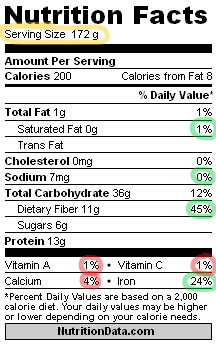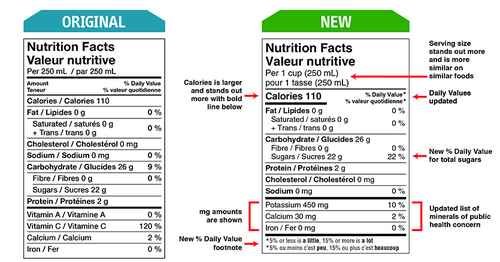We’ve all seen it before, but do you really know what it means and what it’s saying? There’s a TON of information found on nutritional labels, and figuring out how to read it may be daunting. However, it is still a very useful and needed skill to have to make informed choices for your diet. The good news is, your days of googling what it all means are done! We’ve summarized the key info you need in just a few paragraphs. So let's get decoding!
Nutrition Labels
There are two key pieces of information that all prepackaged foods in Canada must have:
- Nutrition Facts Table
- Ingredients List
We’ll dive deeper into what each of those comprise of and how we can use that information.
Nutrition Facts Table
The nutrition facts table must include serving size, calories, % Daily Value, and information about 13 core ingredients. Serving sized is based on what a person usually eats, and % DV is based on the Recommended Daily Intake for vitamins/minerals, and reference standards for other nutrients.
This is how you should use the information given on the label:
- LOOK at the amount of food.
- Compare the serving size to the amount you actually eat
 READ the % DV
READ the % DV
- There’s a benchmark to see if a specific food has a lot or a little of a certain nutrient:
-
≤5% is A LITTLE, ≥15% is A LOT
- Serves as a good guideline to see which ingredient you want more or less of when choosing what to get. In general, aim for foods with more fibre, iron and calcium, and look for less saturated fat, sodium and sugar.
Sometimes it’s not as clear just based on the nutrition facts table which option is the healthier one. If you’re getting confused, focus on comparing one or two specific nutrients you want to include or reduce in your diet. For example, you might look for a canned soup with less sodium and more fibre.
Ingredient List
The ingredient list includes all the ingredients that are in the product. They are listed in order of heaviest to lightest weight. They must also specify if the product has risk of having any of the 11 priority allergens, gluten, or added sulphites. There are certain products that are exempt from having an ingredient list: alcohol, bulk food, and single serve packages.
Reading the ingredients list along with a nutrition facts table can help you make an informed decision. Look for food products that have ingredients you recognize and want to include in your diet, for example on bread you might look for ‘whole grains’ as one of the first ingredients. Reduce the number of foods in your grocery cart that have long and confusing ingredient lists, as these are typically highly processed items like cookies, packaged meals, and snack bars.
Remember: some of the healthiest foods have no nutrition tables or ingredients at all… fresh produce, bulk unsalted nuts or seeds, and fresh lean meat are just a few examples.
New Changes!
As of 2017, Health Canada has been re-branding their food labels to make them easier to read, and change what’s being included. You may have seen some of these new labels already, but ALL food labels will have the updated style by 2022. So what are some of the changes?
- Grouping all sugars. Ingredients containing sugar e.g. fructose, maple syrup would be listed separately. By grouping them together, if there is a significant amount of sugar in the product, it will be listed much higher up in the list.
- Clear formatting. There will be standardized font, font size, periods between ingredients, space etc. Calories will also be bolded and in larger font.
- Consistent Serving Size. Instead of having one product with 1 slice of bread and another 2 slices, it will be standardized for easier comparison.
- Adding %DV for Sugar and Potassium. The total amount in ‘mg’ will also be added for calcium, iron and potassium.
- % DV footnote. A reminder that ‘5% or less is a little’ and ‘15% or more is a lot’ of a nutrient will be added to the bottom of the label.

 Source: Health Canada
Source: Health Canada
These are just a handful of changes being implemented to allow consumers be more informed about their food choices.
If you have any questions, don’t hesitate to contact our UW registered dietitian Nicole Pin. There is also more information found on Health Canada’s section on Food Labels.
Happy Eating!





